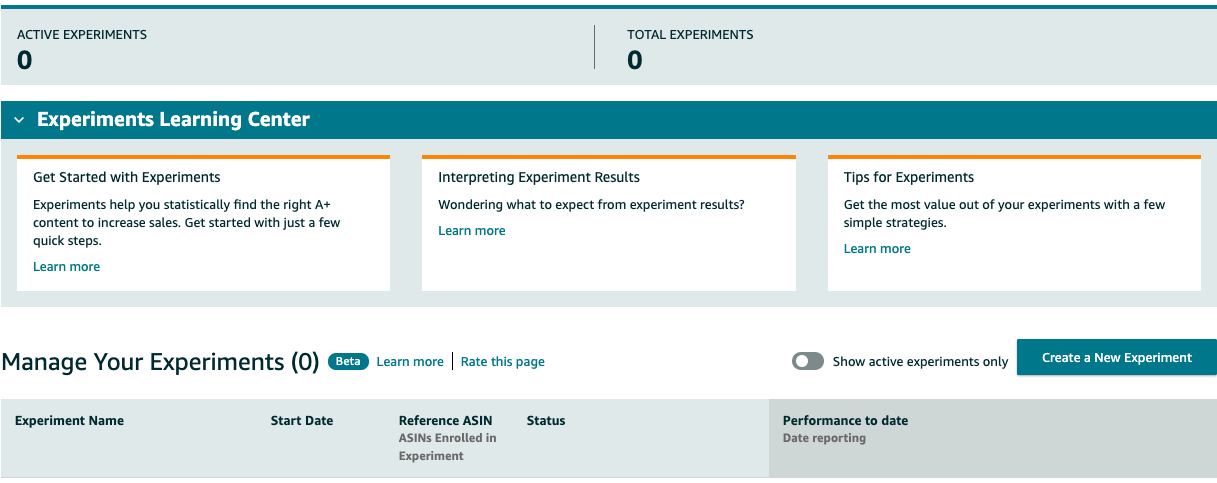Just like other marketplaces, Amazon has been rapidly evolving their algorithm and seller processes over the years.
What worked in 2019 may not work this year, due to some recent changes.
In this article, you will learn strategies involving newer Amazon programs that you can implement now to give yourself the best chance to rank organically and increase sales.
1. A+ Testing
A+ Content is the below-the-fold media that allows sellers to further expand upon their selling points as well as create an enhanced buyer experience.
Sellers are limited to modules pre-selected by Amazon, however, when deployed properly A+ content can increase conversion rates dramatically.
Recently Amazon introduced A+ split testing, something that has not been available to sellers before:

To access this feature simply login to your seller central account and select A+ Content Manager to see if any of your ASINs are eligible.
Prior to testing any A+ content there are some guidelines that I’d like to share to ensure your content has the basic elements.
High-Quality Lifestyle & Product Imagery
A picture says a thousand words.
In this case, you’re likely competing against hundreds of listings that are similar products.
The best piece of advice:
Don’t cheap out on your photography.
Hiring a professional photographer is always a worthwhile investment as it lends trustworthiness to your listing.
If you don’t have the budget for a photographer a cell phone with a good camera and great editing will work.
Just be sure your photography conveys the value of your products.
Share Your Company’s Passion & History
This will not apply to all sellers.
However, having a company with an interesting background can be a great differentiating factor for a listing.
Some things to think about are the following:
- What’s the history of your company?
- What prompted the creation of the products?
- Clearly explain to the consumer why your company has a passion for the products you’re listing.
- Where are you located?
- For those that import this will not apply to you. However, if your products are manufactured in the country of the Amazon marketplace your listing is on it could be a huge advantage. With the recent increase in reporting of counterfeit products on Amazon this will help increase your conversion rate by making the user feel at ease about the legitimacy of your product.
Tell a Convincing Product Story
Help the customers envision using your product. Walk them through how your product is different than the other listings and how it will make their lives better.
Appeal to multiple audiences by focusing on all possible benefits of your products.
The classic example is garlic presses… which are in effect just a simple device that smashes garlic into delicious goodness.
However, including a blurb about the press being suitable to users that are left-handed might increase your conversion rate for those users that are lefties.
After you have the basics for the A+ content completed, it’s time to start testing and optimizing for conversions.
Some basics when starting your listing’s A+ testing:
Move the Listing’s A+ Content Modules Into Different Locations
Every module on your A+ content should have a different selling point.
Test the order of these modules to help optimize your storytelling and buyer’s journey.
Lifestyle vs. Product Images
Some consumers relate more to lifestyle images, whereas some want to see more of the product up close.
I’ve found it beneficial to test the two to see which has a higher conversion rate.
Upon completion of this test, you can then test A+ content with a combination of both.
Test Different Modules
Every module has different image guidelines as well as text placements.
Keep testing which combination works best for your listing.

2. Voice of the Customer
This can be one of the greatest tools to use when writing A+ content and Amazon product descriptions.
Many sellers tend to overlook and underutilize Amazon’s “Voice of the Customer” under the Performance tab feature in Seller Central.
The tool is quite simple, Amazon instructs users to:
“Use this page to understand the Customer Experience (CX) Health of your offers, review product or listing feedback from customers, and take action to fix product and listing issues.”
Sellers will often treat this feature as a means to respond to negative reviews and to monitor their listing’s overall rating.
However, if you dig a little deeper into what the customers are saying it can drastically improve your listing and A+ content.
There are two main trends I tend to look for in the reviews:
Overpromising on the Product
There’s no shame in hyping up your product in your descriptions and A+ content.
The problem arises when you overpromise on a feature which sets the consumer up for high expectations.
This often results in multiple 1-star reviews that will negatively impact your conversion rate.
It’s important that you read through these reviews and determine where in the content of your listing you are conveying the misconception to the customer.
By editing your content to correctly set expectations sellers will save themselves many headaches and negative reviews.
Overdelivering on the Product
If your reviews reveal customers surprised by features or the quality of your product, that’s never a bad thing.
More than likely it resulted in a 5-star review that will help the listing out in the long run.
The only problem that arises is that when you’re overdelivering and customers are surprised, it means you’re missing selling opportunities in your listing.
Utilize these reviews to see how you can improve the content of your listing and to ensure you are not missing any key selling angles.
3. Request a Review

Launched late last year, Amazon’s “Request a Review” feature was introduced to help sellers improve their star rating as well as to combat review manipulation.
While the overall benefit of using the feature has yet to be seen for sellers it can be beneficial to go through their orders on a daily basis for requests.
Being that it is extremely difficult and important for new products to garner positive ratings and reviews this free tool is something that every seller should be utilizing.
It’s quick, only a few clicks, and has the potential to help the overall positive rating optics grow.
4. Amazon Posts
Amazon describes Posts as follows:
“Posts is a new browse and discovery experience on Amazon focused on brand-shopping. Posts help shoppers discover new products and see what’s new from brands by browsing feeds of brand-curated content. Amazon Posts link to product detail pages, making each post in a feed shoppable, and each post includes category tags so shoppers can continue exploring posts in related categories.”
Creating a post is quite simple.
However, there is a 2,200-character count limit and one image limit:

Think of Amazon Posts as a long-form Instagram post that will live on their listings.
While this is a new service, I can see Amazon expanding upon this program to create a more “social feel” on the site in 2020.
As with many programs like Posts, it’s better to be a first-mover while your competitors are still overlooking it.
To make things simple brand owners can simply repurpose their current social media content into Amazon Posts.
It’s quick, free, and there’s no real downside in participating in the program.
5. Amazon Attribution
Amazon Attribution allows sellers to measure their non-Amazon marketing tactics are impacting their overall sales.

Prior to Amazon Attribution generating an ROI for non-Amazon spend was difficult if not impossible.
This made it problematic for marketers to accurately determine where to allocate marketing budget for their Amazon listings.
One of the best methods for testing attribution is to have a solid and highly persuasive product-specific landing page.
For visitors reaching this landing page via non-Amazon ads, this will be their first chance to view your product in-depth and to make a purchasing decision.
Run small tests across all social platforms to see which one is right for you.
Why Should You Be Testing Amazon Attribution?
- It allows Amazon sellers a new method to generate and measure new demand through social networks. Not every consumer begins their buyer’s journey on Amazon and Attribution helps gives the consumer a way to reach them.
- Finding the right combination of landing pages, ads, audiences, and networks will allow sellers to scale their marketing efforts increasing the product’s sales velocity. While there are many factors that go into Amazon’s ranking algorithm, velocity is one of the most important.
- Launching new products will be easier. Since new products have little to no reviews or ratings it’s likely not seen as a bad thing in the user’s perception of the listing. Having a solid landing page introducing the new product as well as social media videos and ads to support it will give you an edge over competitors.
More Resources:
- 4 Reasons Why Every Retailer Should Embrace Amazon
- How to Find & Understand the Conversion Rate of Your Products on Amazon
- 11 Amazon Advertising Mistakes to Avoid in 2020
Image Credits
All screenshots taken by author, February 2020


